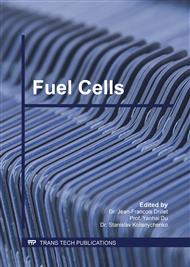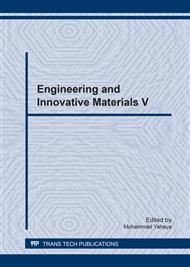p.159
p.165
p.173
p.178
p.184
p.191
p.195
p.201
p.209
Potential of Palm Oill Mill Effluent (POME) as Growth Medium for Sulfate-Reducing Bacterium in Microbial Fuel Cell
Abstract:
This study is conducted to determine the potential of palm oil mill effluent (POME) as medium for growing sulfate-reducing bacterium (SRB) in anaerobic condition for microbial fuel cell application. In this study, effect of different percentage (20-70%) of POME was investigated on the growing cell of SRB. The bacterium was propagated in 400 ml Schott bottle at 35°C, pH 7.8 purged with nitrogen gas. The optical density during the growth of SRB was measured using UV-Vis Spectrophotometer at 600nm wavelength and the weight of dry cell was calculated to determine the specific growth rate. The highest specific growth rate (0.0636/hr) of SRB was achieved using 20% of POME compared to the media without POME (0.0464/hr). The increment is around 37%. The output voltage with 20% of POME is 0.23V which is 55.5% improvement compared to the medium without POME, thus proved that POME has the potential as growth medium for SRB in anaerobic condition for microbial fuel cell application. Booster circuit is possible to be used to boost the output voltage of the MFC until 3V which is more useful for electronic applications.
Info:
Periodical:
Pages:
184-190
Citation:
Online since:
March 2017
Price:
Сopyright:
© 2017 Trans Tech Publications Ltd. All Rights Reserved
Share:
Citation:



